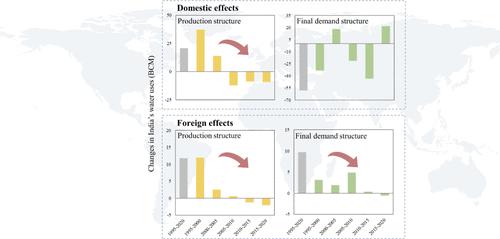Global Supply Chains are Becoming Conducive to Water Saving in India
引用次数: 0
Abstract
India is an emerging region in global socioeconomic development and international trade and has the largest freshwater withdrawals worldwide. India’s water use is affected by changes in domestic and foreign socioeconomic development. However, socioeconomic driving factors of India’s water use in the context of global supply chains have not been investigated. This study explored the impacts of domestic and foreign socioeconomic transitions on water use in India during 1995–2020. Results show that the effect of the change in water use intensity on reducing India’s water use has gradually diminished and even led to water use increments in recent years (+11 billion m3 (BCM) during 2010–2020). Notably, the changes in global economic structures show significant potential for water saving in India (−15 BCM during 1995–2020). The change in the domestic final demand structure was a critical factor contributing to water saving in India (−58 BCM during 1995–2020). In particular, the changes in production structures (both domestic and foreign) and foreign final demand structures have shifted from contributing to India’s water use increments to water use reductions. This study highlights the importance of global economic structure optimization and international cooperation for water savings in India.

全球供应链正成为印度节水的有利条件
印度是全球社会经济发展和国际贸易的新兴地区,也是全球淡水取水量最大的国家。印度的用水量受到国内外社会经济发展变化的影响。然而,在全球供应链背景下印度用水的社会经济驱动因素尚未得到研究。本研究探讨了 1995-2020 年间国内外社会经济转型对印度用水的影响。结果表明,用水强度的变化对减少印度用水量的影响逐渐减弱,甚至导致近年来用水量的增加(2010-2020 年期间用水量增加 110 亿立方米)。值得注意的是,全球经济结构的变化显示出印度节水的巨大潜力(1995-2020 年间-150 亿立方米)。国内最终需求结构的变化是印度节水的一个关键因素(1995-2020 年间-580 亿立方米)。特别是,生产结构(国内和国外)和国外最终需求结构的变化已经从印度用水量的增加转变为用水量的减少。本研究强调了全球经济结构优化和国际合作对印度节水的重要性。
本文章由计算机程序翻译,如有差异,请以英文原文为准。
求助全文
约1分钟内获得全文
求助全文

 求助内容:
求助内容: 应助结果提醒方式:
应助结果提醒方式:


